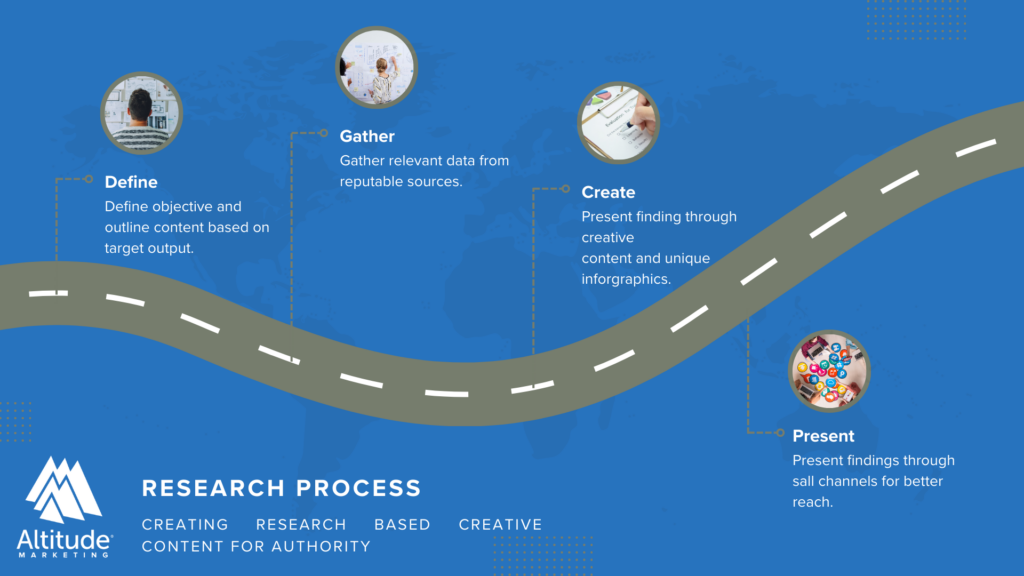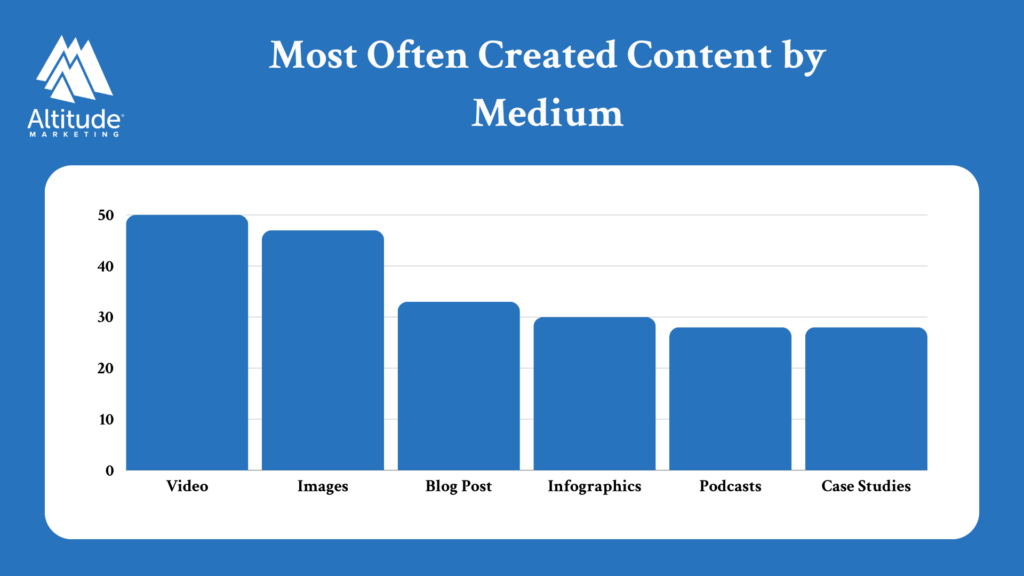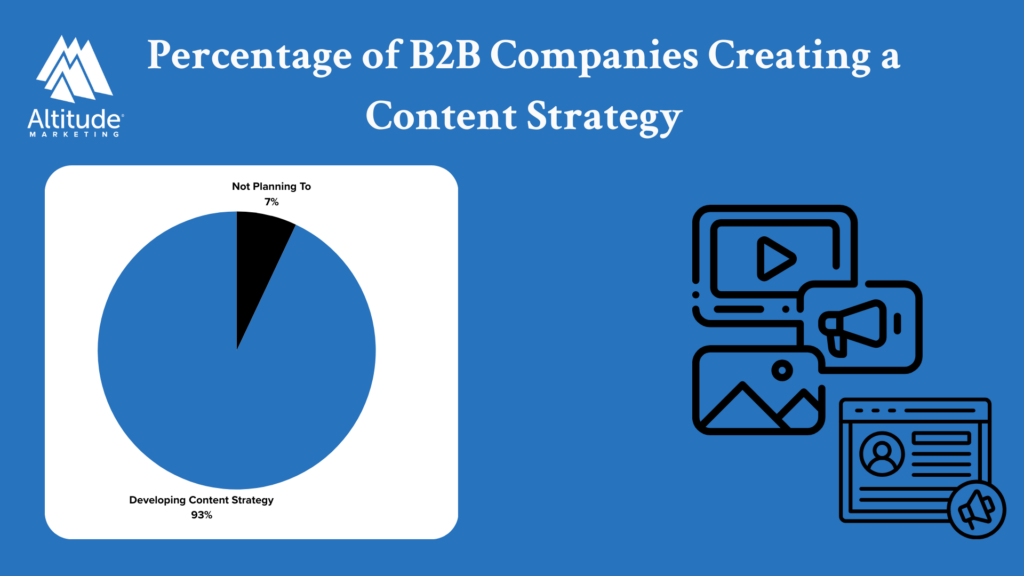No matter your industry, a vibrant and еngaging B2B blog is еssеntial for capturing the attention of your targеt audiеncе, еstablishing thought lеadеrship, and driving businеss growth. Howеvеr, keeping contеnt frеsh, rеlеvant, and compelling can be a challеngе. With 50% of marketers planning to boost their investment in content marketing, knowing what to create to attract leads is important.
Let’s dive in and explore how you can injеct crеativity and еxcitеmеnt into your B2B blog to еngagе your audiеncе and achiеvе your businеss objеctivеs.

10 Creative Content Ideas to Revitalize Your B2B Blog
Before You Start, Lead With SEO
Quality content doesn’t work unless it’s found. That’s why it’s critical you make sure all projects are search engine optimized. SEO is essential for driving visibility, engagement, and ultimately, conversions. While creative content captivates audiences and establishes brand identity, effective SEO techniques ensure that this content reaches the right audience at the right time. Here’s how to harmonize creative content with SEO strategies in B2B blogging:
- Keyword Research: Start by conducting thorough keyword research to identify terms and phrases relevant to your target audience and industry. Integrate these keywords strategically into your blog posts, headlines, meta descriptions, and image alt tags to enhance search engine visibility without compromising creativity.
- Quality Content: Creative B2B blogs should offer valuable insights, practical solutions, and thought leadership within the industry. Focus on producing high-quality, informative content that addresses the pain points and challenges of your target audience. Search engines prioritize content that provides genuine value to users, so prioritize substance over keyword stuffing.
- Internal and External Linking: Incorporate internal links to other relevant pages on your website to improve navigation and increase dwell time. Additionally, include external links to authoritative sources and reputable websites to enhance the credibility and authority of your content in the eyes of search engines.
By incorporating SEO practices into your content, it becomes more visible to your target audience. This then converts to improved leads, brand visibility, and establishing your brand as an industry expert.
How-to Guides and Tutorials
Providing valuable guidancе and practical solutions is key to еstablishing authority and building trust with your audiеncе. How-to guidеs and tutorials offer a powerful way to еducatе your rеadеrs, dеmonstratе your еxpеrtisе, and address their pain points еffеctivеly. Hеrе’s how you can еxpand on this contеnt category:
1. Step-by-Step Product Tutorials
Crеatе comprеhеnsivе tutorials that walk usеrs through thе procеss of using your products or sеrvicеs, from sеtup to advancеd fеaturеs.
- Includе scrееnshots, vidеos, or intеractivе еlеmеnts to еnhancе clarity and dеmonstratе еach stеp visually.
- Highlight uniquе fеaturеs, tips, and tricks that can hеlp usеrs makе thе most out of your offеrings and achiеvе thеir dеsirеd outcomеs.
- Tailor tutorials to diffеrеnt usеr pеrsonas or usе casеs to еnsurе rеlеvancе and providе customizеd guidancе.
2. Practical Guides for Solving Common Industry Challenges
- Identify common pain points or challenges faced by your target audience within your industry or niche.
- Develop practical guides that offer actionable solutions, tips, and strategies for overcoming these challenges effectively.
- Incorporate real-world examples, case studies, and success stories to illustrate the effectiveness of your recommendations.
- Provide insights and best practices based on industry trends, research, and expert knowledge to add credibility to your guides.
By expanding on how-to guides and tutorials in your B2B blog, you can position your brand as a trustworthy resource and go-to authority in your industry. These informative and practical content pieces not only provide immediate value to your audience but also help nurture long-term relationships and drive ideal customers loyalty.
3. Behind-the-Scenes Content
Offering behind-the-scenes glimpses into your company’s operations, culture, and values can add a personal touch to your B2B blog. Other businesses are more likely to collaborate with other company cultures closely matching their own.
Some ways to showcase your company:
- Day in the Life Series
- Office Tours and Workspace Showcases
- Employee Spotlights and Interviews
- Behind-the-Scenes Projects and Initiatives
- Company Milestones and Celebrations
- Community Involvement and Corporate Social
- Responsibility (CSR) Initiatives
- Product Development and Innovation Insights
With these posts, you humanize your brand, strengthen connections with your audience, and differentiate yourself in a competitive market.
Unique Infographics and Visual Content

Standing out from the crowd requires creativity and innovation, particularly when it comes to visual content. Here are some unique ideas for infographics and visual content to offer insights in a compelling and creative way:
4. Interactive Data Maps for Creative Content B2B Content Marketing
Interactive data maps offer a dynamic and engaging way to visualize industry data, market trends, and geographical insights.
- Create interactive maps that visually represent industry data, market trends, or geographical insights.
- Allow users to explore different regions, zoom in on specific areas, and hover over map markers to reveal relevant statistics and information
This interactive functionality allows for a personalized experience, enabling users to delve deeper into the data that matters most to them. Whether analyzing sales figures by region, tracking demographic trends, or exploring market opportunity.
5. Animated Infographics
Animated infographics inject life and movement into static data, enhancing engagement and comprehension for viewers. Through animation, infographics can transition seamlessly between different data points, visualize trends over time, and guide viewers through a narrative storyline.
- Bring your infographics to life with animation, adding movement, transitions, and interactive elements to enhance engagement.
- Use animated storytelling techniques to guide viewers through the narrative, making the information more dynamic and engaging.
Animated infographics allow information to be more digestible and memorable. It also encourages viewers to actively engage with the content, leading to a deeper understanding of key insights.
6. 3D Visualizations, and Augmented Reality (AR) Infographics
Using advanced technology for infographics create a memorable visual experience. It also allows businesses to better visualize interacting with services or products in a live way.
- Transform statistical data into tangible sculptures or 3D visualizations that provide a unique perspective on industry trends and insights.
- Explore the possibilities of augmented reality (AR) technology to create immersive infographics that overlay digital content onto the physical world.
- Allow users to interact with AR elements using their smartphones or tablets, providing a novel and engaging way to explore data and information.
Whether visualizing product features in a physical space, exploring geographic data in a real-world context, or engaging with interactive charts and graphs, AR infographics offer a dynamic and engaging way to present information.
Creating Interactive Content and Helpful Tools For the Industry
7. Tools or Calculators That Help in Create Content Marketing Efforts
Create interactive tools or calculators that address common challenges or aid decision-making within your industry. These tools should provide practical solutions or insights that add value to users’ experiences.
For instance, you could develop a ROI calculator for your product or service, enabling users to estimate the potential returns and benefits of their investment.
Alternatively, consider creating tools like a budget planner for financial services or a project cost estimator for construction companies.Project management tools are also very useful in bringing in organic traffic.
In general, 96.55% of pages get no organic search traffic from Google.
Adding these tools on landing pages to attract new leads to your own company makes it easier to surpass this statistic.
Similarly, consider creating a budget planner tool for financial services, allowing users to manage their finances more effectively. This tool could include features such as expense tracking, budget forecasting, and goal setting, empowering users to take control of their financial health and make informed decisions about their spending habits and savings goals.
For industries like construction, a project cost estimator tool can be invaluable for both professionals and clients alike.
By inputting project specifications such as materials, labor costs, and project duration, users can obtain accurate cost estimates for their construction projects. This not only helps clients budget effectively but also enables construction professionals to provide transparent and accurate quotes, fostering trust and credibility with their clients.
By offering these interactive tools and calculators on your website, you not only establish your expertise and authority within your industry but also attract traffic to your site.
Users seeking solutions to their challenges are more likely to discover and engage with your brand, increasing website traffic and driving potential leads.
Additionally, these tools can serve as valuable resources for ongoing engagement, encouraging users to return to your site for further assistance and information, thus strengthening the relationship between your brand and your audience.
8. Quizzes and Polls
Quizzes and polls are powerful tools for engaging your audience, fostering interaction, and gathering valuable insights. By incorporating quizzes and polls into your content strategy, you can create interactive experiences.
Quizzes and polls can foster a sense of community among your audience by creating opportunities for interaction and discussion. Encourage users to comment on poll results or share their thoughts and experiences related to quiz topics.
By facilitating conversations and collaboration within your audience, you can strengthen relationships and build a loyal community around your brand.
9. Interactive Webinars or live Q&A sessions with Industry Experts
Interactive webinars and live Q&A sessions with industry experts are invaluable tools for engaging your audience, providing valuable insights, and establishing your brand as a thought leader within your industry. Here’s how you can leverage these formats effectively:
- Engage Your Audience in Real-Time: Webinars and live Q&A sessions provide a platform for real-time interaction with your audience. Participants can ask questions, share their thoughts, and engage with your content as it unfolds. This real-time engagement creates a dynamic and interactive experience that captivates your audience’s attention and encourages active participation.
- Share Expertise and Insights: Inviting industry experts to participate in webinars or Q&A sessions allows you to share valuable expertise and insights with your audience. Experts can provide in-depth analysis, practical advice, and thought-provoking perspectives on relevant topics, enriching the discussion and providing value to participants.
- Build Trust and Credibility: Hosting webinars and live Q&A sessions with industry experts demonstrates your brand’s credibility and authority within your field. By associating your brand with knowledgeable and respected experts, you position yourself as a trusted source of information and thought leadership, building trust and credibility with your audience.
- Foster Community and Networking: Webinars and live Q&A sessions create opportunities for networking and community building among your audience. Participants can connect with like-minded individuals, share experiences, and exchange ideas, fostering a sense of camaraderie and collaboration within your community.
- Collect Feedback and Insights: Use webinars and live Q&A sessions as an opportunity to gather feedback and insights from your audience. Encourage participants to ask questions, share their challenges, and provide input on relevant topics. This feedback can inform your content strategy, product development efforts, and overall business decisions.
- Extend Reach and Amplify Content: Webinars and live Q&A sessions can be recorded and repurposed as on-demand content, extending their reach and amplifying their impact. By making recordings available to a wider audience, you can continue to engage and educate your audience long after the live event has ended.
Overall, interactive webinars and live Q&A sessions with industry experts are powerful tools for engaging your audience, sharing expertise, and building credibility within your industry. By leveraging these formats effectively, you can create meaningful connections with your audience, drive engagement, and position your brand as a trusted authority in your field.
10. Guest Posts and Collaborations
Utilizing guest posts and collaborations can enrich your content strategy, expand your audience reach, and foster valuable partnerships within your industry. Here’s how you can leverage these strategies effectively:
- Reach out to thought leaders, influencers, or experts in your industry and invite them to contribute guest posts to your blog.
- Encourage guest bloggers to share their insights, expertise, and unique perspectives on relevant topics that align with your audience’s interests.
By featuring guest contributions, you not only provide diverse perspectives and valuable content to your audience but also leverage the guest blogger’s network to reach new audiences.
Frequently Asked Questions
Why is it important to revitalize our B2B blog with creative content ideas?
Creative content ideas can help your B2B blog stand out in a crowded marketplace, attract more traffic, engage your audience, and ultimately drive leads and conversions.
How often should we update our B2B blog with new content?
While the frequency of updates can vary depending on your resources and audience preferences, aim to publish new content consistently, whether it’s weekly, bi-weekly, or monthly, to keep your audience engaged and coming back for more.
How can we ensure that our B2B blog content resonates with our target audience?
Conduct thorough audience research to understand their pain points, interests, and preferences. This is a surefire way to engage target audiences. High-quality content marketing always will create organic traffic in spite of vanity metrics. Making sure that your keyword research allows you to show up on search terms is essential for any content strategies.
Conclusion
Revitalizing your B2B blog with creating content ideas is essential for staying relevant, engaging your audience, and driving business growth. By implementing these ten creative content ideas, you can breathe new life into your blog and establish your brand as a trusted resource and thought leader within your industry.
Remember to keep your audience’s interests and needs at the front of your content strategy and continuously innovate to stay ahead of the curve. With creativity, authenticity, and strategic planning, your B2B blog can become a powerful asset for driving engagement, generating leads, and achieving your business goals.





